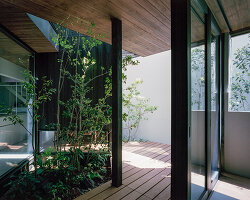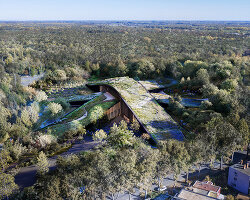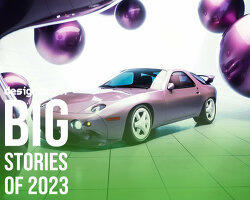UPDATE: on february 23, 2021, a groundbreaking ceremony took place to mark the start of the project’s construction. ‘the woven city project officially starts today,’ said toyota president akio toyoda. ‘together with the support of our project partners, we will take on the challenge of creating a future where people of diverse backgrounds are able to live happily.’ read designboom’s previous article from january 2020 below.
toyota has revealed plans to build a prototype ‘city of the future’ on a 175-acre site at the base of mount fuji in japan. designed by bjarke ingels group, ‘woven city’ will feature a fully connected ecosystem powered by hydrogen fuel cells. the project was announced at CES 2020, where toyota detailed plans to use the city as a laboratory for autonomous cars, smart homes, artificial intelligence and other technologies developed by the japanese automaker.
live from las vegas: designboom is covering all the latest launches of CES 2020 – the world’s largest consumer technology fair – from the trade show grounds. stay connected for the future of technology as it debuts.

the woven city will act as a human incubator for toyota to experiment with driverless vehicles, robotics, smart home technology and artificial intelligence | all images courtesy of toyota
the fully connected ecosystem will serve as a home to full-time residents and researchers who will be able to test and develop driverless vehicles, robotics, smart home technology and artificial intelligence in a real-world environment. around 2,000 people will be able to live in the woven city, including toyota‘s own researchers as well as space reserved for retirees, families and retailers.

2,000 people will be able to live in the woven city, including toyota’s own researchers
the city is being designed by bjarke ingels group (BIG), led by danish architect bjarke ingels. scheduled to break ground in 2021, it will be built on a stretched grid of pathways that aim to separate designations for self-driving mobility pods, pedestrians, and lower-speed mobility devices like electric scooters and bicycles. these three street types weave together to form an organic grid pattern to help accelerate the testing of autonomy.
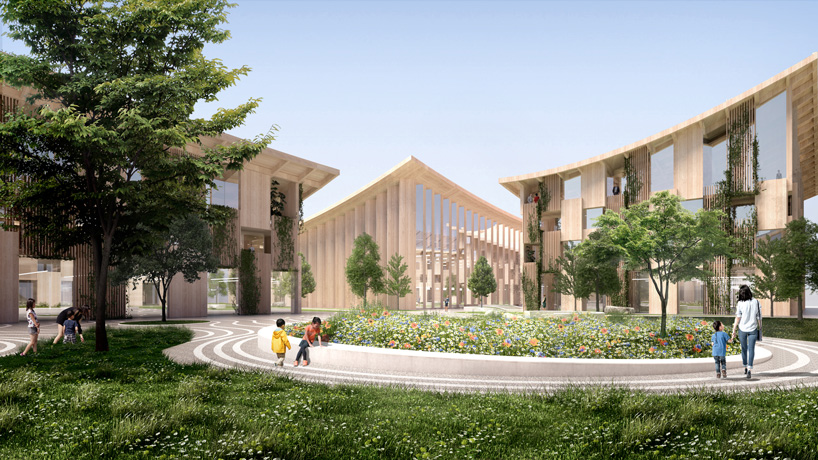
the woven city features a sustainable design with buildings made mostly of wood
‘today the typical street is a mess with everything and nothing everywhere, so we started by splitting the typical street into three separate forms of mobility,’ bjarke ingels, founder and creative director of BIG, said at a press conference detailing the concept. ‘the first type is for faster transportation — and every vehicle is autonomous with zero emissions — street trees create the necessary distinction between people and vehicles.’
bjarke ingels discusses toyota woven city at CES 2020
‘the second type will be an urban promenade shared by pedestrians and slower personal mobility…and the final type of street will be a linear park with paths for pedestrians only.’
‘these 3 types of streets will then weave together into a woven grid of 3 x 3 city blocks, each framing a local park or courtyard. this not only creates a more serene living environment but also provides a wide variety of intersections between various kinds of users. humans…to help accelerate toyota’s testing of autonomy and smart city infrastructure.’
combining robotic production methods with traditional japanese wood joinery, the woven city features a sustainable design with buildings made mostly of wood to minimize the carbon footprint. the rooftops will be covered in photovoltaic panels to generate solar power in addition to power generated by the hydrogen fuel cells.
‘the buildings are made primarily of carbon neutral wood and combine the traditional craft of japanese wood joinery with new robotic production methods,’ ingels adds. ‘in a way we can preserve and evolve the old traditions through new technology.’
‘each block is home to a mix of spaces for living and working. below ground we find the entire infrastructure of the city including its hydrogen power storage and water filtration systems. a network for the autonomous delivery of goods also takes place underground connecting directly to the buildings above.’

public areas include neighborhood parks and a large central park for recreation
to move residents through the city, only fully-autonomous, zero-emission vehicles will be allowed on the main thoroughfares. in and throughout woven city, autonomous toyota e-palettes will be used for transportation and deliveries, as well as for changeable mobile retail.
toyota also plans to weave in the outdoors throughout the woven city, with native vegetation and hydroponics. public areas include neighborhood parks and a large central park for recreation, as well as a central plaza, designed to bring the community together. toyota believes that encouraging human connection will be an equally important aspect of this experience.
‘a swarm of different technologies are beginning to radically change how we inhabit and navigate our cities,’ explains ingels. ‘connected, autonomous, emission-free and shared mobility solutions are bound to unleash a world of opportunities for new forms of urban life. with the breadth of technologies and industries that we have been able to access and collaborate with from the toyota ecosystem of companies, we believe we have a unique opportunity to explore new forms of urbanity with the woven city that could pave new paths for other cities to explore.’

toyota plans to weave in the outdoors throughout the woven city, with native vegetation and hydroponics
‘building a complete city from the ground up, even on a small scale like this, is a unique opportunity to develop future technologies, including a digital operating system for the city’s infrastructure,’ says akio toyoda, president, toyota motor corporation. ‘with people, buildings and vehicles all connected and communicating with each other through data and sensors, we will be able to test connected ai technology… in both the virtual and the physical realms… maximizing its potential.’
residences will be equipped with the latest in human support technologies, such as in-home robotics to assist with daily living. the homes will use sensor-based AI to check occupants’ health, take care of basic needs and enhance daily life, creating an opportunity to deploy connected technology with integrity and trust, securely and positively.

toyota is combining robotic production methods with traditional japanese wood joinery to minimize the carbon footprint
toyota will extend an open invitation to collaborate with other commercial and academic partners and invite interested scientists and researchers from around the world to come work on their own projects in this one-of-a-kind, real-world incubator: ‘we welcome all those inspired to improve the way we live in the future, to take advantage of this unique research ecosystem and join us in our quest to create an ever-better way of life and mobility for all,’ toyoda adds.
interested in partnering with toyota on the development of woven city?

the prototype city will occupy a 175-acre site at the base of mt. fuji in japan

toyota’s LQ concept was also on show at CES featuring an air-purifying layer that reduces ozone emissions (read more)
image © designboom
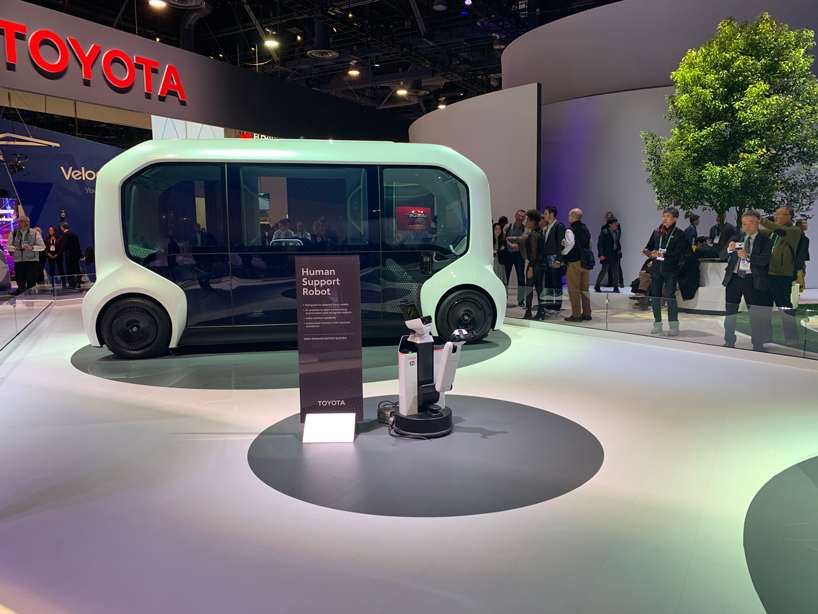
residences will be equipped with the latest in human support technologies, such as in-home robotics to assist with daily living
image © designboom

the woven city will be built on a stretched grid of pathways that accommodate self-driving mobility pods, pedestrians, and lower-speed mobility devices like electric scooters and bicycles
image © designboom

image © designboom

in and throughout woven city, autonomous toyota e-palettes will be used for transportation and deliveries
image © designboom
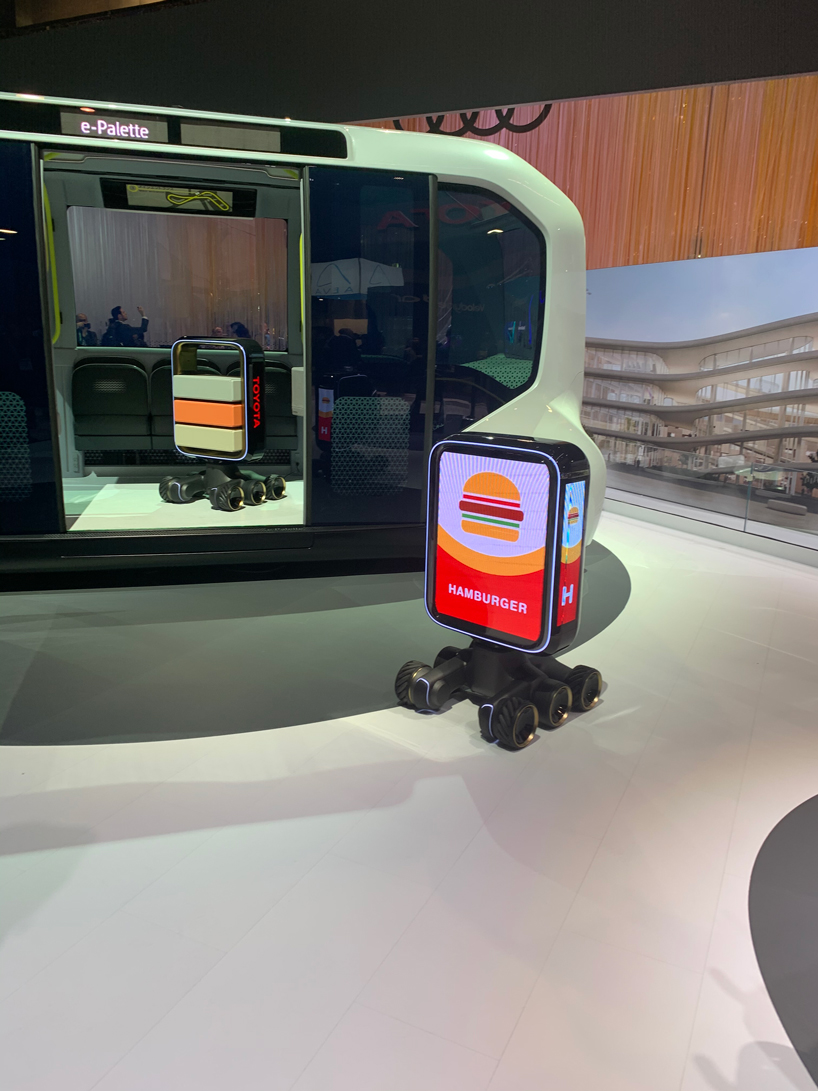
they include changeable mobile retail devices that function like signs on wheels
image © designboom
project info:
name: toyota woven city
type: commission
size: 175 acres / 708,200 sqm
location: susono city, shizuoka, japan
client: toyota motor corporation + kaleidoscope creative
collaborators: squint opera, mobility in chain, atelier ten
event: CES 2020
BIG – bjarke ingels group —
partners-in-charge: bjarke ingels, leon rost
project manager: yu inamoto
project leader: giulia frittoli
team: agla egilsdottir, alvaro velosa, brian zhang, john hein, joseph baisch, mai lee, margherita gistri, nicolas lapierre, peter sepassi, raven xu, samantha okolita, shane dalke, thomas mcmurtrie, yi lun yang, nasiq kahn, jeffrey shumaker



